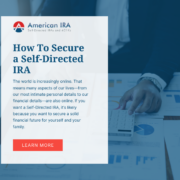Self Directed IRAs and Risk
 Self-directed IRA investments are just that – investments. And investments of any kind come with risks. Here are the most common types of risk that self-directed IRA investors encounter – and some ways to counteract them.
Self-directed IRA investments are just that – investments. And investments of any kind come with risks. Here are the most common types of risk that self-directed IRA investors encounter – and some ways to counteract them.
Longevity risk. This is the risk that you may outlive your retirement assets. Common hedges include lifetime income annuities, rental real estate, and preferred stock, each of which may provide income as long as you live.
Market risk. This is the risk that the stock market or bond markets may decline, leaving you less financially secure, with less wealth and/or capacity to create income than you anticipated. The time-honored way to counteract this type of risk is diversification, including ownership of assets such as real estate, precious metals or other nonstandard asset classes as part of your retirement savings strategy.
Interest rate risk. When interest rates rise, bond prices fall. If you depend on bonds for your retirement income, you may be vulnerable to unplanned increases in interest rates. These can be short-term or long-term interest rates. To mitigate this risk, consider other sources of income that aren’t related directly to interest rates, such as direct ownership of rental real estate.
[tweetthis twitter_handles=”@iraexpert” hidden_hashtags=”#SelfDirectedIRA”]Most common types of risk that self-directed IRA investors encounter…[/tweetthis]
Mortality risk. This is the risk that you will die sooner than expected, leaving loved ones without your earning capacity. Life insurance is the most efficient mortality risk hedge, but you cannot own life insurance within a self-directed IRA.
 Inflation risk. This is the risk that the dollar’s purchasing power will decline. Most paper assets are vulnerable to inflation risk. Common hedges include ownership of gold, precious metals, real estate, commodities, land or businesses. It may also help to keep at least part of your portfolio positioned for growth, rather than income, as growth-oriented investments may have a better chance at beating inflation and delivering positive real returns over the long haul.
Inflation risk. This is the risk that the dollar’s purchasing power will decline. Most paper assets are vulnerable to inflation risk. Common hedges include ownership of gold, precious metals, real estate, commodities, land or businesses. It may also help to keep at least part of your portfolio positioned for growth, rather than income, as growth-oriented investments may have a better chance at beating inflation and delivering positive real returns over the long haul.
Legislative and regulatory risk. This is the risk that an action by a state or federal legislative body or regulator could have a negative effect on one or more of your investments. For example, while Roth IRAs currently generate tax-free income for long-term investors, and do not generate a required minimum distribution for those over age 70, it’s possible that future Congresses could change the rules. At the regulatory level, it’s also possible that the IRS will frown on certain models of self-directed IRA investing, such as the ‘checkbook IRA,’ where there are few safeguards or barriers to the mingling of retirement and personal funds, or where the potential for improper use of retirement funds for personal benefit is high. We tend to caution our clients and encourage them to stick to conservative, proven practices when it comes to self-directed IRA investing.
Reinvestment risk. This is the risk that, if interest rates fall, proceeds from future cash flows will have to be reinvested at lower interest rates than initially projected.
American IRA, LLC has helped thousands of investors successfully diversify themselves and protect their retirement assets against all these types of potential risks. For a no-obligation consultation, call us at 866-7500-IRA(472), or visit us online at www.americanira.com
Images by: presentermedia.com





